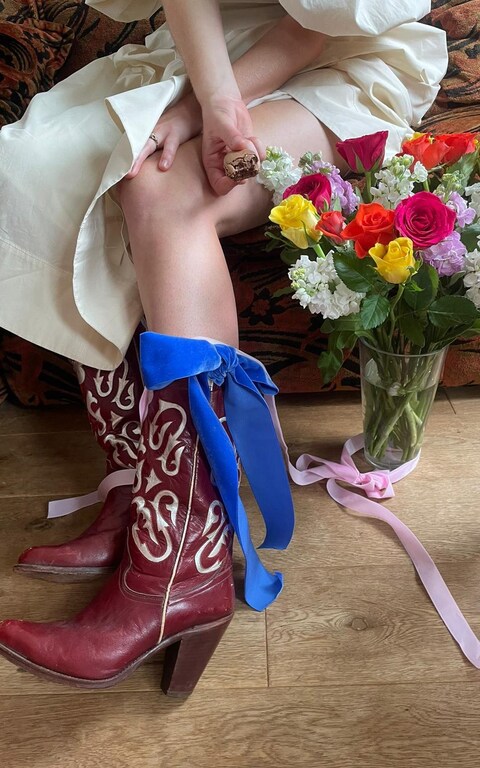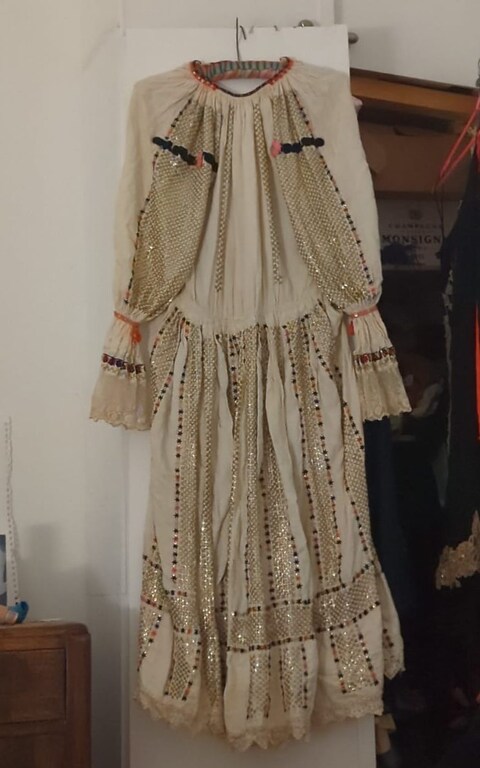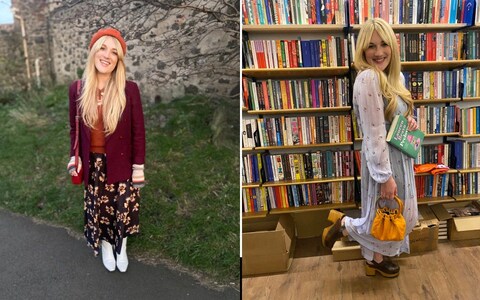There is not much to distinguish the Shelter charity shop from the high-end boutiques it rubs shoulders with in London’s glossy Coal Drop Yard – except the prices.
Silk dresses cost £20; leather jackets are £40 and brand-new trainers are just £15. Then there are the few discreet television screens within the beautifully-designed, cavernous space in King’s Cross stocked with rails of clothes, homeware and art that tells customers how devastating homelessness can be and where exactly their money is going.
Turns out it’s boom time in the bargain business. While bricks-and-mortar stores struggle to survive the online retail revolution, charity shops including the one run by Shelter, which is dedicated to finding a home for everyone on the streets, are doing better than ever.
Revenue is up by more than 15 per cent this year. As the cost of living crisis bites and shoppers choose between brand new glam and their local Oxfam, many are plumping for the latter.
“I find the high street overwhelming these days but there’s something incredibly soothing about the unpredictability of charity shops,” says author Lauren Bravo, whose novel Preloved is set in one. “Maybe you’ll strike gold, maybe you won’t. Maybe you’ll find something that fits perfectly and feels made for you, maybe you won’t. The joy is in the rummage.”
Bravo first caught the charity shop bug in childhood. “It’s a habit that goes back as far as I can remember. My parents have always been keen second-hand shoppers – partly through necessity, when money was tight and they had three kids to clothe, but also because they just love treasure-hunting and giving a new home to something with a bit of history.”
Treasure-hunter Lauren Bravo’s new novel is set in a charity shop
Credit: Lauren Bravo
Now the pieces in Bravo’s wardrobe that she returns to for parties, birthdays and major work events almost all come from charity shops. “One of my best buys was a 1950s French military jacket that I picked up for £20; a vintage Mulberry handbag for £85, and my dining table, which cost just £250 and was made from old railway sleepers.”
And while second-hand apps like Vinted, Depop and even eBay are proliferating – and helping all of us get more accustomed to wearing pre-loved clothes – the charity shop sector is unique in that the money goes to a good cause, rather than someone else’s pocket.
“Anything you spend really matters, and it’s rare to be able to say that,” says Hattie Lamb, community space manager at Shelter. “This makes something fun like shopping feel genuinely worthy. The housing crisis is a huge problem and it’s hitting more and more people – and by finding something that you love in our store, you can help someone find a safe and secure home. It’s so easy, and it makes you feel great.”
Last year the “social value” of the difference the charity shop sector makes to society was estimated at a whopping £75 billion.
Lamb herself now rarely buys anything new. “I feel cheated if I shop on the high street because I know whatever I’ve bought will be available in a charity shop somewhere,” she says. “I’ve also started to realise how much better the quality of clothes was 30 years ago – a good jumper that you buy new today is nowhere near as well-made as the cashmere pieces we get sent all the time.”
With a wardrobe and a house almost exclusively stocked with charity shop buys, it is difficult for Lamb to play favourites. “For my recent wedding, I did buy a new dress but I wore it with £20 charity shop cowboy boots I found in Edinburgh.” She also has what she thinks is a traditional Russian dress made out of linen with metal sequins that cost just £20.


Hattie Lamb wore her wedding dress with these £20 charity shop cowboy boots


Lamb’s £20 sequin dress
Lamb’s south London flat is almost entirely decorated with charity shop finds. “We have some really great stuff we could never have afforded new,” she says. “I found a pair of yellow suede leather Ligne Roset chairs, which can cost up to £1,000, for £25 each. I also love a poster from the 1990s for one of David Hockney’s early exhibitions in LA. It cost just £40.”
These two women are not alone. At the end of a difficult year, the overt commercialism of Christmas can feel jarring, which is why plenty of people are trying to weave charity shopping into their annual festive traditions.
One colleague says her family has agreed to charity-shop bought stockings, while plenty of office secret Santas are following the same path. Someone else tells me about a Christmas party she’s been invited to where the dress code is “charity shop finest”.
But are we really ready to buy the majority of our presents second-hand? “We need to stop feeling squeamish or embarrassed about gifting from a charity shop,” says Bravo. “It can be a great way of giving something worth more – a designer brand, for example – than you might be able to spend if it were new, or something truly unique that the recipient wouldn’t be able to find on the high street.”
Certain charity shops also have relationships with brands and will sell on new stock they no longer need. Shelter, for example, was recently given some of Vivienne Westwood’s old collections (one jacket on their rails costs £350; the original price was £1,020). This is still relatively rare in the fashion industry but pressure is being placed on brands not to incinerate clothes they no longer need, but to instead give them to a worthy cause.
But charity shops offer more than just clothes when it comes to gifts. “I think old books make gorgeous presents for keen readers, especially if you can hunt out a first edition,” she adds, noting that Oxfam is selling a first edition of Sylvia Plath’s Ariel online for £169.
“Crockery and ceramics are always a great idea, as are classic brass candlesticks or beautiful coloured glassware – and for accessories, you can’t go wrong with good quality leather goods (which often look better with a little age) or a beautiful silk scarf, which is so versatile and can even be framed as a piece of art.”
Charity shops also feature cabinets with jewellery and designer accessories and because children grow out of clothes so quickly, you can find beautiful barely-worn baby and kids’ clothes. As for toys: check all the pieces are present and correct (for jigsaws, shop staff will hopefully have done this for you) and be vigilant about age ratings to make sure that older toys are safe for the recipient.
But for the right piece at the right price, a charity shop is your best chance of picking up a festive bargain. Here are our top tips for treasure hunting.
Head for affluent areas
“The posher parts of London can be a thrifting goldmine: Notting Hill and Ladbroke Grove have some amazing charity shops, as does Primrose Hill, Highgate and Hampstead,” says Bravo. “Battersea’s Northcote Road is one of the best crawls in the capital, from hot trends at Traid to designer labels at Royal Trinity Hospice.”
Bravo adds that she does a lot of charity shopping in Edinburgh, too, while Lamb says Bristol is a particularly fruitful city (“people are very charity-minded there so they give a lot of great stuff”)
Shop on a Friday
“Charity shops add new stock to their rails every night and the amount of donations accumulates as the week goes on,” says Lamb.
“This means the shelves will be stuffed full, ready for the busy weekend by Friday. So it’s a great day to shop to beat the weekend rush.”
Look for clothes with the labels cut out
“High street fashion stores sometimes have deals with charity shops, where they donate unsold items as long as we cut the labels off,” says Lamb.
“These clothes will be completely unworn and heavily reduced. So if your friends and relatives aren’t sniffy about getting a gift without the label attached, this could be a great option.”
Use your hands
In an age where so much shopping is done in front of a screen, charity shops also offer us the chance to touch the pieces we want to buy. “My biggest tip for charity shopping is to use touch,” says Lamb.
“You need to find good quality fabrics and you can do this more easily if you’re going down a row with your hands and your eyes, rather than just looking.”
Look for places with older populations
Anywhere with a high proportion of elderly residents tends to be good for authentic 1960s and 1970s vintage. “My home county of Sussex has some great coastal spots with lots of elderly residents,” says Bravo.
“Hastings & St Leonards and neighbouring Bexhill are all heaving with real vintage treasure troves, and really well-priced.” Equally, anywhere north of Manchester is a lot cheaper than the South East.
Let staff know what you’re looking for
“If you’ve something particular in mind, chat to staff as they might have just the thing which they haven’t yet put on the shop floor,” says Lamb. “If you’re a regular, they might even start keeping an eye out for things they know you like.”
Look online
Most charities, including Shelter and Oxfam (which has a large range of sizes), have websites too. Lamb also recommends checking eBay.
“Ebay lists products from a number of featured charities, which is particularly handy for people who don’t live close to a shop or have accessibility issues,” she says.
Aim for vintage prints
If the clothing you are considering is vintage rather than second-hand, aim for prints and embroidered pieces instead of plain black or other solid-colour items as they tend to age less well. And keep your options open– if you go out looking for a white dress, you probably won’t find it.
Know what to pay
Charity shops tend to mark down heavily, even for something brand new. “We usually do a third of what it should cost,” says Lamb. “And of course the condition counts – if it’s a bit scruffy, we take off even more. And even if a piece is absolutely brand new it’s always less than half.”
Don’t worry about cleaning
Clothes in charity shops are always thoroughly steamed before they hit the shop floor, which kills bacteria, so there’s no need to wash them again unless you really want to.
“If vintage items have a lingering odour, hang them outside in the fresh air for as long as possible, or try soaking them in diluted vodka or diluted white vinegar,” says Bravo.
And finally … do your bit and donate!
If you have items to donate, consider whether you would want to buy it yourself before dropping it off. If the answer is yes, then bring it in, says Lamb.
“We do get a lot of soiled things, which are obviously a no, and we are inundated with broken plastic toys which we can’t sell – so think twice about those too.”
This year’s Telegraph Christmas Charity Appeal supports four charities: Go Beyond, Race Against Dementia, the RAF Benevolent Fund and Marie Curie. To make a donation, please visit telegraph.co.uk/2023appeal or call 0151 284 1927
This post was originally published on this site be sure to check out more of their content.









